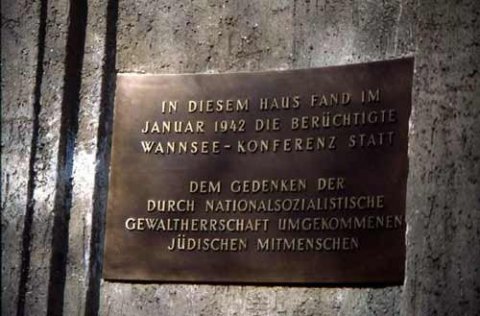The Wannsee Conference
Sous-titre
20 January 1942
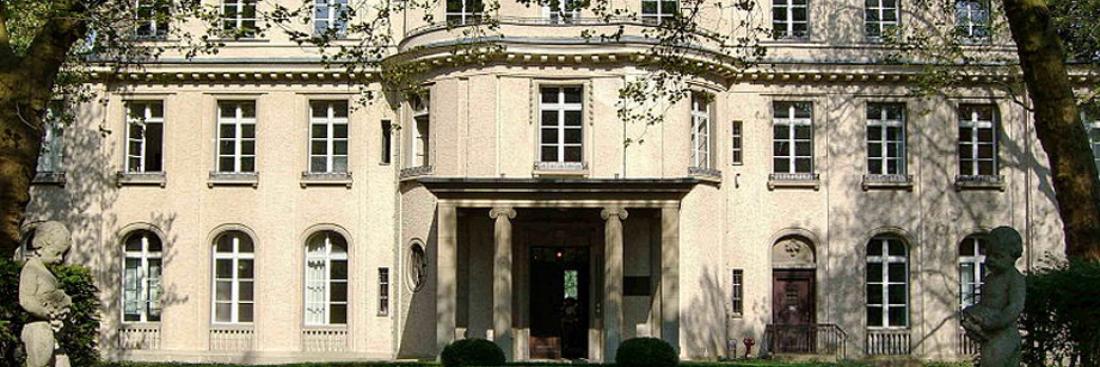
Although there is still some debate among historians, the Wannsee Conference is considered to be where the “Final Solution to the Jewish Question” was decided, because it established Heydrich’s authority in the matter, brought together the key figures responsible for the extermination, and was where the planning took place for the annihilation.
A definition of the “Final Solution” to the Jewish question
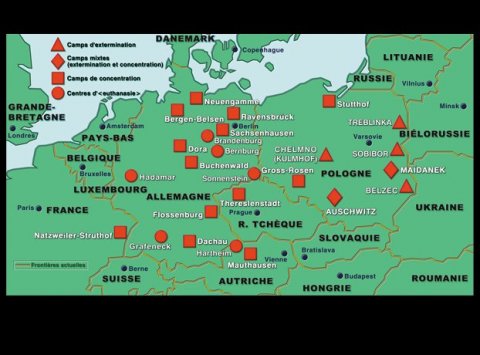
Map of the main concentration and extermination camps. Source: SGA/DMPA
Convened by Reinhardt Heydrich, Heinrich Himmler’s number two and the head of the RSHA (Reich Security Head Office), the conference took place on 20 January 1942 and, according to Adolf Eichmann’s testimony, lasted between one and one and a half hours. It was attended by only a small number of protagonists, representing practically all of the ministerial bureaucracy and Nazi apparatus responsible for the “Final Solution”.
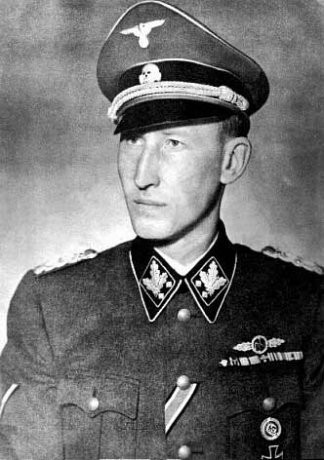
Reinhardt Heydrich, head of Reich security. Source: German Federal Archive
The minutes are clear enough: “Under proper guidance, in the course of the final solution the Jews are to be allocated for appropriate labour in the East. Able-bodied Jews, separated according to sex, will be taken in large work columns to these areas for work on roads, in the course of which action doubtless a large portion will be eliminated by natural causes. The possible final remnant will, since it will undoubtedly consist of the most resistant portion, have to be treated accordingly, because it is the product of natural selection and would, if released, act as a the seed of a new Jewish revival.” (1)
This extract from the minutes, drawn up mainly by Adolf Eichmann, is often cited, because it has the merit of being almost crystal clear. The expression “Final Solution” is defined here. “Able-bodied Jews” – “fit for work”, as they were often described – would be exploited beyond human dignity. Any who survived this deadly labour posed the main threat. In the Nazis’ biological world view, they contained the strain of a virus that could contaminate the entire world, and could only be eradicated by means of “special treatment”, which can only be assumed means death.
The work of historians
However, over the past two decades, many works have been produced, by mainly German and American historians, that question the importance of the conference. Some, by no means lesser figures – Hans Mommsen, for instance, in his famous article ‘The Realization of the Unthinkable: The “Final Solution of the Jewish Question” in the Third Reich’ (2) – believe that there was never an actual decision taken by Hitler. Others believe that a decision was taken, but that it came earlier: the conference took place at a time when large numbers of Jews, in particular those of the Soviet Union, had already been murdered, and gassing had begun, since lorries had been in operation since 7 December 1941 at Chelmno nad Nerem (renamed Kulmhof by the Nazis), approximately 70 km west of Lodz (Litzmannstadt). Others still – though few and without much of a following – mainly on the basis of the timeline of killings at Auschwitz, argue that the decision came later, in spring 1942. All agree, however, that Wannsee’s importance is relative.
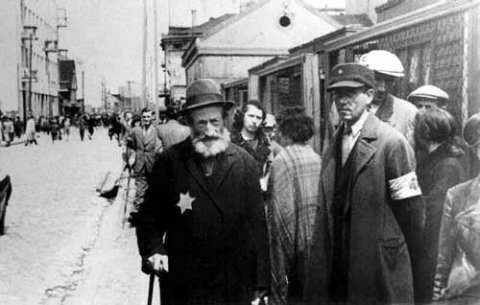
Lodz Ghetto, the Jews’ distinguishing star. Source: Rights reserved
A young German historian, Christian Gerlach, revisited the conference in a text that attests to the dynamism of research and debate across the Rhine (3). He drew on newly updated sources, namely Himmler’s diaries, discovered in Moscow archives and published in Germany. It was under the auspices of the RSHA that Heydrich convened this meeting to discuss the issue of the “final solution to the Jewish question”. The conference began with the announcement by Heydrich, chief of the Security Police and the SD, of his appointment by Göring to the post of “plenipotentiary for the preparation of the final solution to the problem of the European Jews”. On 31 July 1941, Göring, who up until then had been in charge of coordinating the anti-Jewish programme, had signed a text entrusting Heydrich with the task of making “all the necessary preparations” for implementing “a comprehensive solution to the Jewish question throughout Germany’s sphere of influence in Europe”. He asked him, in addition, to provide him “promptly” with an overall plan of the preliminary steps required for the execution of that final solution” (4). As Philippe Burin notes, this completed the mandate issued to Heydrich on 24 January 1939 to coordinate the emigration of German Jews. He was now given the task of extending “its scope to the whole of Nazi Europe [...]. Formally, the solutions envisaged were emigration and evacuation.”
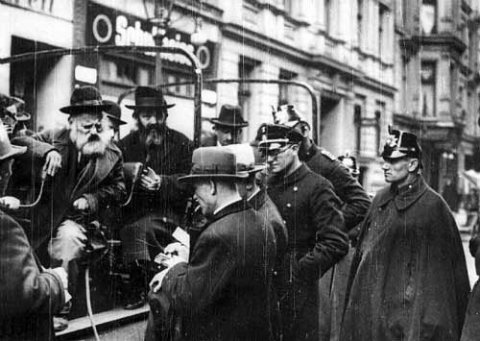
Jews being rounded up in north Berlin. Source: German Federal Archive
The Mischling question
To some historians, the purpose of the meeting was for all to acknowledge Heydrich’s authority over the “final solution of Jewish question”. They base their argument on the fact that one of the issues discussed at length concerned the Mischlinge, people of mixed Jewish and “Aryan” descent. It was a key issue that proved an obsessive, recurrent obstacle. Wilhelm Stuckart, a state secretary at the Ministry of the Interior, was well aware of this problem, which had already been raised when the Nuremberg Laws were drawn up in 1935. Although the Nazis’ aim was to cut all ties between Jews and German society, the Mischlinge were living evidence of the reality of those ties. Questioning their belonging to “the race” could trigger protests and disturbances in sectors of German society linked to them through family ties. This explains why, in 1935, interior ministry experts, who took a more moderate approach, and party fanatics had been at loggerheads.
The issue was raised once more at Wannsee. Should it be settled during the war or left until after the conflict? While everyone agreed that someone with three Jewish grandparents was also Jewish, and that someone with one Jewish grandparent was not Jewish, there was lively debate about those with two Jewish grandparents. The fates of some 200 000 people depended on the results of that debate – 70 000 to 75 000 first-degree Mischlinge (two Jewish grandparents) and 125 000 to 130 000 second-degree Mischlinge (one Jewish grandparent). It was therefore proposed that first-degree Mischlinge should be “reclassified” as Jews, unless they were married to a German and were therefore the mother or father of second-degree Mischlinge, or they had served the German people. As for second-degree Mischlinge, they would be regarded as Germans, with a few exceptions. These conclusions seemed rather complicated to Stuckart. To him, the solution was simply sterilisation (5). In this area, the conference can be said to have contributed little. Heydrich gave a report on the results of the mission with which Göring had entrusted him in January 1939 – Jewish emigration – which was reproduced in the minutes of the conference. To “accelerat[e] the emigration of the Jews from Reich territory”, Heydrich had been put in charge of the Reich Central Office for Jewish Emigration, whose main tasks were “a) to make all necessary arrangements for the preparation for an increased emigration of the Jews, b) to direct the flow of emigration, c) to speed the procedure of emigration in each individual case.” According to the minutes, that solution, which earned Adolf Eichmann renown in Vienna, then Berlin, enabled 537 000 Jews to leave the Reich by 31 October 1941. However, “[in] the meantime, the Reichsführer-SS and Chief of the German Police had prohibited emigration of Jews due to the dangers of an emigration in wartime and due to the possibilities of the East.”
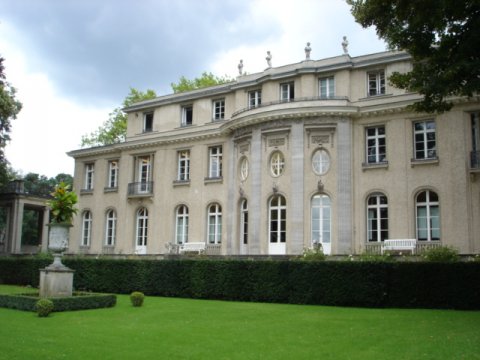
The Wannsee Villa, where the conference was held. Source: GNU Free Documentation License
The massacres carried out in the Soviet Union in 1941
While 537 000 Jews had been able to emigrate, about the same number were murdered as the Wehrmacht advanced into the Soviet Union, in the second half of 1941, by the Einsatzgruppen operating behind the front line. No mention was made of these mass murders by firing squad in the minutes of the meeting. Yet it is precisely this first phase of killing of men, women and children that raises the question for historians of the decision, which is at the heart of Gerlach’s text. Was a decision actually taken to exterminate? And if so, was it taken before the invasion, or during it? While certain documents signed by Heydrich show that the Einsatzgruppen were tasked not only with ensuring the transitional control of the population – as was the case in Poland in 1939 – but also with executing certain categories of people, including some Jews, this did not apply to all Jews, only those that held positions of authority in the communist party and the Soviet State. For Philippe Burin, the escalation in the murder of Jews “saw a decisive turning point sometime between the end of July and the end of August, when women and children were included in the massacres. [...] The Jews manifestly paid with their lives, in exponentially increasing numbers, for the extension of a campaign that should have ended in September” (6).
Yet while these massacres unquestionably constituted genocide, it remained regional. Therefore, if a decision was taken to eliminate the Jewish population, there is nothing to suggest that it was general and applied also to Western European Jews. This calls into question the very meaning of the expression “final solution”.
Wannsee: a turning point in the elimination of European Jews
For Gerlach, there was only genuinely a “final solution” if the Jews, without any exception, including nationality, were destined for destruction. Any decision that may have been taken can therefore be “dated” by examining the fate of the Jews whose nationality was provisionally exempted from the killing, i.e. German Jews.
Today, one of the “important sites of Berlin’s criminal topography is undoubtedly the house at 56-58 Am Großen Wannsee” (7). Following Gerlach’s study, the distance between a scholarly history that diminished the importance of Wannsee and the collective memory which inflated it became smaller. If the destruction of European Jews did not begin at Wannsee, it was there that it took a radical shift and really became “final”, no longer sparing any category.
